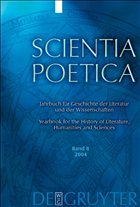Das - bislang vom Max-Niemeyer-Verlag betreute - Jahrbuch erscheint seit 1997 und hat die Aufgabe, Literatur- und Wissenschaftsgeschichte aufeinander zu beziehen. Es reagiert damit auf die Erweiterungen der Fragestellungen und Methoden, die sich in den letzten Jahrzehnten in beiden Disziplinen herausgebildet haben. Aus der Erkenntnis heraus, dass der literarisch-künstlerische und der (natur)wissenschaftliche Diskurs keine getrennten Sphären sind, die losgelöst voneinander angemessen beschrieben werden können, bietet das Jahrbuch ein transdisziplinäres Diskussionsforum für die historische Analyse der Wechselwirkungen zwischen den (Natur-)Wissenschaften und der Literatur(- Wissenschaft) in den Theoriebildungs- und Reflexionsprozessen vom hohen Mittelalter bis zur Gegenwart. Zum Gegenstandsbereich des Jahrbuchs gehört der Kanon der Wissenschaften, den die mittelalterliche Universität begründet hat und der in neuerer Zeit um Disziplinen wie die Naturwissenschaften, die Psychologie, Soziologie oder Geschichtswissenschaft erweitert wurde. Die Festlegung des Gegenstandsbereichs schließt den bewussten Verzicht auf eine thematische Begrenzung der vielfältigen Zeiten, Disziplinen und Aspekte ein. Die Publikationssprachen sind Deutsch und Englisch. Das Jahrbuch wird bei De Gruyter in bewährter inhaltlicher Konzeption weitergeführt. Neben den Herausgebern gestaltet ein internationaler Beirat renommierter Wissenschaftler die Scientia Poetica. Das Jahrbuch erscheint künftig in hochwertiger Ausstattung (Hardcover) und im Umfang erweitert. Im Rahmen des Internet- Auftritts des Verlages wird außerdem eine Service-Webseite eingerichtet, die die Programmatik des Jahrbuchs, Abstracts der Beiträge, Kurzrezensionen, eine Linkliste, Informationen für Autoren und Bezieher usw. bietet.
Formerly published by the Max Niemeyer Verlag, the yearbook has been in publication since 1997 and has the task of applying the fields of literary and scientific history to one another. In doing so, the yearbook reacts to the expansion of problems and methods which have emerged in both disciplines over the last decades. Building on the insight that literary-artistic and (natural)-scientific discourse are not two separate spheres and cannot be properly described separate of one another, the yearbook offers a transdisciplinary discussion forum for the historical analysis of the interactions between the (natural) sciences and literature (studies) in theory development and reflection from the late Middle Ages to the present. One of the topics of the yearbook is the canon of the sciences, which was founded by medieval universities and which in recent times has been expanded to include disciplines such as the natural sciences, psychology, sociology and the science of history.
Formerly published by the Max Niemeyer Verlag, the yearbook has been in publication since 1997 and has the task of applying the fields of literary and scientific history to one another. In doing so, the yearbook reacts to the expansion of problems and methods which have emerged in both disciplines over the last decades. Building on the insight that literary-artistic and (natural)-scientific discourse are not two separate spheres and cannot be properly described separate of one another, the yearbook offers a transdisciplinary discussion forum for the historical analysis of the interactions between the (natural) sciences and literature (studies) in theory development and reflection from the late Middle Ages to the present. One of the topics of the yearbook is the canon of the sciences, which was founded by medieval universities and which in recent times has been expanded to include disciplines such as the natural sciences, psychology, sociology and the science of history.

